NEPPA eNewsletter
November 2010
EXECUTIVE DIRECTOR'S REPORT
In October, at two different locations in New York state, 14 young men employed by municipal electric utilities completed four years of study and field work as apprentice lineworkers and received their official certificates of completion. These young men thus joined earlier graduates of NEPPA’s Apprentice Lineworker Program in New York, which is provided by NEPPA to municipal utilities in that state through a contract with the New York Municipal Electric Utilities Association.
I attended both graduation dinners in New York last month, and got to see for myself the quality of these young men and the obvious respect that they held for their program instructors, their chosen careers, and their fellow lineworkers. To a person, they demonstrated pride in having successfully completed four years of demanding book learning and field training (especially climbing and performing difficult physical labor on tall utility poles), and gratitude for having learned their trade under the guidance of two experienced utility hands. They expressed their gratitude in both heartfelt words and thoughtful gifts to their instructors as their graduation dinners concluded.
The two instructors who led these programs are Bill Hesson and Lou Gabriele, long-time NEPPA trainers who are only too happy to share their knowledge and skills with the next generation of pubic power lineworkers in New York state. Beyond getting through all the "book learning" and climbing drills with their students however, Bill and Lou also make sure that each and every student in their classes has a keen appreciation for their good fortune to be holding such positions, and for the dangerous nature of their work. Above all else, safe working habits and procedures underlie every one of their classroom lectures and field demonstrations.
These young men are extremely fortunate to have such experienced and dedicated teachers as they begin their careers in public power. Bill and Lou have each spent over thirty years in electric utility linework in New England, and they bring a passion for the work as well as real know-how to their classes. For each of them however, safety is paramount, which means taking the time necessary to understand the work to be done, planning for contingencies, and never taking short cuts. In electric utility linework, unlike most other professions, the consequences of sloppy work or poor preparation can be serious injury or death, as they both know all too well.
Bill Hesson and Lou Gabriele perform an essential service in the electric utility industry. They both serve as a "bridge" between generations, transferring hard-won knowledge and skills to young lineworkers, and making sure that each of their young students has mastered the fundamentals of this challenging and rewarding profession. In teaching young men how to master the lineworker’s trade, they are "paying it forward," and their lessons will live on for many years to come.
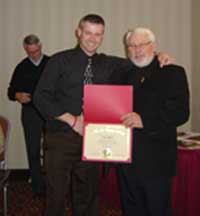
Larry Imhoff, Village of Little Valley, receives his certificate from NEPPA Trainer Bill Hesson.
##SHARELINKS##
|
ASSOCIATION HAPPENINGS
Nearly 100 NEPPA utility members and affiliates met at historic Mechanics Hall in Worcester, Mass. on Nov. 5 for NEPPA's Annual Membership Meeting and a celebration of NEPPA's 45 years of service to the New England public power community. Executive Director Pat Hyland took a look back in his report to remind everyone what has happened to our industry and our world in the past 45 years. He also updated members on future plans for the association including a report on the Littleton Building Project. After the 2011 budget was approved, NEPPA affiliate members were given an opportunity to give brief descriptions of their products and services. Bobby Fosmire and the Sharptones entertained attendees with sixties music up to and during lunch while members socialized and networked.
Below are photos are some of the corporate and associate members who attended the meeting.
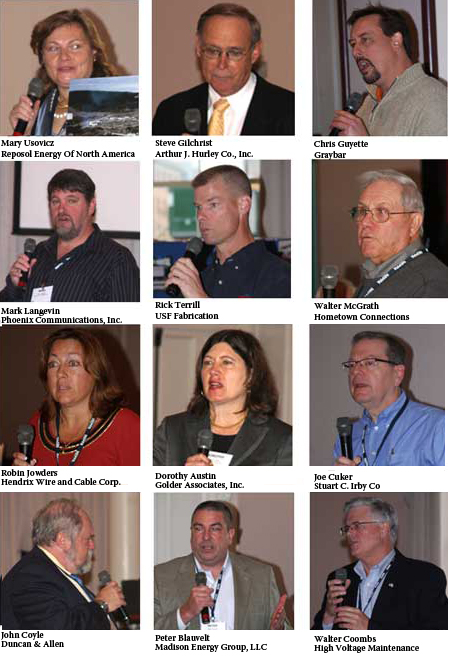
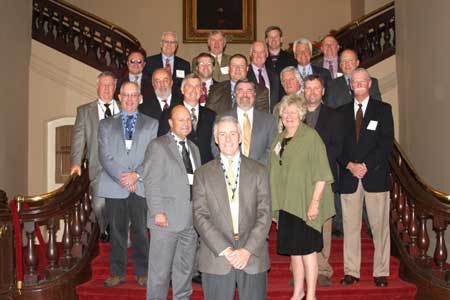
NEPPA Board of Directors
Front, center, Patrick Hyland, NEPPA Executive Director
First Row, John Hiscock and Barbara Grimes
Second Row, Duncan Hastings, Robert Jolly, John Bilda, Scott Edwards and Vinnie Cameron
Third Row, Richard Joyce, George Lague, John Tzimorangas, Mark Kelly, Sean Hamilton
Fourth Row, James Bakas, Gary Babin, William Bottiggi, Thomas Josie
Fifth Row, Theodore Garille, John Clark, Mike Cloutier, and Calvin Ames
Missing from photograph, Eric Werner
##SHARELINKS##
|
Three NEPPA awards were presented at NEPPA's Annual Membership Meeting on Nov. 5.
George Lague was recognized as a loyal member and leader of public power in New England with a NEPPA Service Award. He plans to retire later this year as village
manager of Swanton, Vt, where he is responsible for the village electric department as well as all other municipal services. In addition to his responsibilities at Swanton, George has been a public power leader in his state, through his service on the Board of Directors of the Vermont Public Power Supply Authority, and in New England, as Director and former President of NEPPA.
"Those of us who have had the pleasure of working with George have come to respect his judgment and candor, as well as his practical approach to problem-solving," said Executive Director Pat Hyland who presented the award. "We have also come to appreciate his sense of humor and his enthusiasm for travel, good stories and spirited debate. He has been an important part of our association for a very long time."
Two NEPPA Century Awards were also presented. Denny Smith, a commissioner at West Boylston Light accepted on behalf of his utility, and Greg DeStasi accepted on behalf of Sterling Municipal Light Department.

Denny Smith and Greg DeStasi accept Century awards.
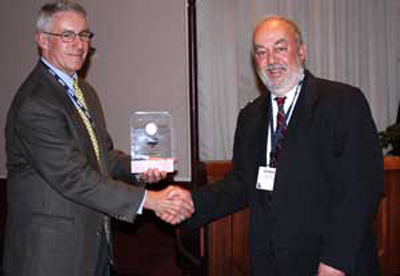
Pat Hyland presents George Lague with a NEPPA Service Award.
##SHARELINKS##
|
CALENDAR
November 17, 2010
Collection Practices Roundtable
9:30 a.m. - 1 pm
Chocksett Inn
59 Laurelwood Road
Sterling, Mass.
March 23 – 25, 2011
November 16 –18, 2011
Public Utility Management Program
Cranwell Conference Center
Lenox, Mass.
June 8 - 9, 2011
Operations Conference and Expo
Courtyard by Marriott
Fitchburg, Mass.
August 21-24, 2011
Annual Conference
Samoset Resort
Rockland, Maine
##SHARELINKS##
|
EDUCATION & TRAINING UPDATE
Now that new guidelines for CPR and ECC have been released, does that mean the "old" guidelines and the "old" way of performing CPR are not safe or effective?
A: The recommendations in the 2010 AHA Guidelines for CPR & ECC confirm the safety and effectiveness of many existing approaches, acknowledge that some may not be optimal, and introduce new treatments that have undergone intensive evaluation. These new recommendations do not imply that care involving the use of earlier guidelines is either unsafe or ineffective. This includes providing CPR using the A-B-C sequence. People should continue to perform CPR just as they were last trained and follow the prompts of the AED that they are using.
Q: When will the new guidelines for CPR go into effect since new materials are not yet available?
A: This month, 2010, AHA will begin conducting official Guidelines Instructor Updates, during which materials will be provided to instructors that allow them to integrate new science into the current courses they are teaching. Until instructors receive these materials, they should continue to teach the same science they have been teaching using the current materials.
To view the complete American Heart Association guidelines, click here.
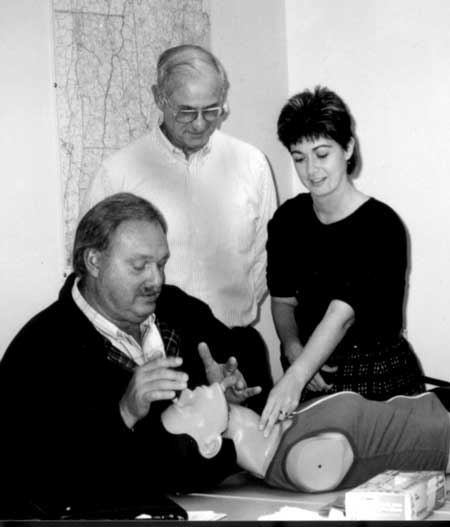
##SHARELINKS##
| |
LEGISLATIVE UPDATE
Republican's Win Control of the House and Pick up Seats in the Senate
Hastings Outlines His Priorities as House Resources Chair
Public Power Meets with Senate Tax Staff and House Leadership on Comparable Incentives
To view articles, click here.
##SHARELINKS##
|
THE LEARNING CORNER
Learning in the workplace is, or should be, linked to job performance. When we access new information or learn a skill, we can incorporate that knowledge into the way we do our jobs. One form of learning that happens frequently (at least, it should happen frequently) is feedback. When our supervisor or colleagues comment on how we are doing, they give us the opportunity to work even better—if the feedback is delivered effectively. Here are some helpful hints about the Do’s and Don’ts of evaluating someone’s work.
The Don’ts:
Don’t "hoard" the feedback. Have you ever had a manager who told you, "If you don’t hear anything from me, you’re doing okay. If you do something wrong, then you’ll hear from me"? This is one of the most dispiriting things a manager can do, for two reasons: first, because everyone has a human need to find out how they are doing; and second, because positive feedback helps motivate employees, whereas a strict diet of negative feedback acts as a demotivator. Who wants to hear how they are doing badly all the time?
Don’t give group-only feedback. Telling an entire group that it is doing well or poorly does not let people know how their individual efforts are aiding or detracting from the group’s overall efforts. Speak briefly with each employee separately. It doesn’t take long, and your subordinates will have a clearer idea of the contribution they are making to the group.
Don’t make your feedback vague. Be specific. Saying "Nice job" or "That won’t work" tells the employee nothing. Which part of the performance was effective? Which needs to be done better? Alluding to what was done particularly well will help reinforce the behavior, and indicating where the performance was lacking allows the employee to make any necessary adjustments.
The Dos:
Do give feedback on an ongoing basis. Many managers give feedback only once a year, at their subordinate’s annual performance appraisal. Unfortunately, this does not allow the subordinate to fix things when they need to be fixed, which in turn means that the inferior performance continues for the entire year.
Be direct with good news, indirect with bad. When your message is positive you can get right to the point, but when making constructive criticism, don’t start off with the negative comment. Use the "plus-minus-plus" approach. Begin with what the person has done well (or at least acknowledge that they have worked hard on the task), then bring up the aspect of the performance that needs to be improved, and end with a word of encouragement. People are more likely to accept criticism if they are also given credit for what they have done well.
And finally, explain the consequence of continuing their current behavior. In other words, what will happen as a result of their performance as it stands now? Keep in mind that consequences can be positive as well as negative. If the person is doing something well, tell them what positive things will result from their good work. Also let them know, however, what negative results will follow from their shortcomings. When you explain to people the consequences of their actions, they come to understand what effect they have on the entire organization, and that in itself can be motivating.
I hope this article was helpful to you...so, how did I do?
##SHARELINKS##
|
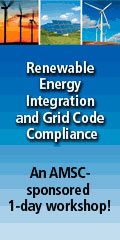
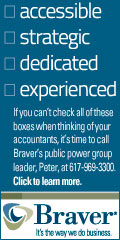
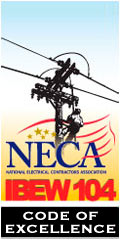

Meet Our Member
Utility Operations – Cyber Security
For help complying with mandatory NERC CIP standards for cyber security and to protect your Smart Grid investments, turn to the experts at N-Dimension Solutions Inc. for their deep knowledge of the federal requirements, proven products, and commitment to public power.

##SHARELINKS##
|
|
|










